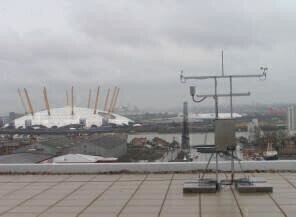Environmental Laboratory
Window Cleaning at Height Weather Monitoring
Mar 10 2010
Many high-rise buildings monitor local meteorological conditions as an aid to determine whether conditions are safe to use cradles while cleaning windows and other working at height applications. To help provide accurate local weather information, Health and Safety managers from a prestigious company in Canary Wharf have recently invested in and installed two automatic weather stations at two different roof levels.
Prior to installing the weather stations, the decision on whether or not to use external cradles relied solely on hand held Anemometers which did not provide sufficiently accurate results. Readings tended to rely too much on where the reading was taken from which did not take into consideration how weather circulated around the building. The hand-held equipment also only took a snapshot recording of the moment it was used and did not take into consideration actual weather patterns or trends.
External contractors used to rely on obtaining predictive information and current trends in weather patterns from the Met Office, which was not always reliable. The Met Office predict huge generic areas whilst weather can be very localised. For instance, ’showers across London’ might mean that Westminster suffers a deluge of rain on that day whilst no rain might fall at Canary Wharf.
Following site surveys with experts from Casella, the best positions for the weather stations were established and installed. The equipment purchased was similar in both locations and includes:
1) The highest roof level records Air Pressure, Air Temperature, Humidity, Rainfall, Wind Speed and Wind Direction.
2) The lower roof level records Air Pressure, Air Temperature, Humidity, Solarimeter (Brightness), Sunshine, Wind Speed, and Wind Direction.
The system information is gathered remotely and relayed via a bus link to the PC users who are allowed access, including three users in the facilities department and one user from the cleaning company.
The system also allows for a selection of averages. In this particular example, a 10 minute average on wind speeds was chosen to provide the most accurate readings possible for each day. This information can then be used to decide whether it is safe or not to use external cradles. Hand-held anemometers are still used but only in conjunction with the weather stations.
The use of the weather stations has revealed two distinct climatic areas at Canary Wharf. In fairly normal weather conditions, the highest roof level tends to have less wind speed than that of the lower roof area due to the
surrounding buildings. This has been checked and verified using two hand-held Anemometers at each weather station.
The weather stations information is still in its infancy but data is steadily growing on a daily and seasonal basis. The weather system allows for records and trends to be recorded over time and the Building Services Department have a vested interest in the external conditions of the building as they look to ensure optimum building usage and working conditions with the possibility of future energy efficiencies from the information obtained on Humidity, Sunshine, the Solarimeter and Rainfall. Data can be used as an aid in all aspects of energy management of the building, to help in improving the overall carbon footprint and efficiency ratings, thereby achieving cost savings.
The other important use of the system is in providing wind speed data which can then be used to protect the Health and Safety of all workers who have access to cradle systems. If average windspeeds or gusts are too high, decisions can be made as to whether work can continue or not. Workers are still required to take manual wind speed readings, but these can now be backed up by the automatic data which is displayed in real time to operatives inside the building.
Digital Edition
IET 34.2 March 2024
April 2024
Gas Detection - Biogas batch fermentation system for laboratory use with automatic gas analysis in real time Water/Wastewater - Upcycling sensors for sustainable nature management - Prist...
View all digital editions
Events
Apr 30 2024 Melbourne, Australia
Apr 30 2024 Birmingham, UK
May 03 2024 Seoul, South Korea
May 05 2024 Seville, Spain
May 06 2024 Minneapolis, MN, USA


















